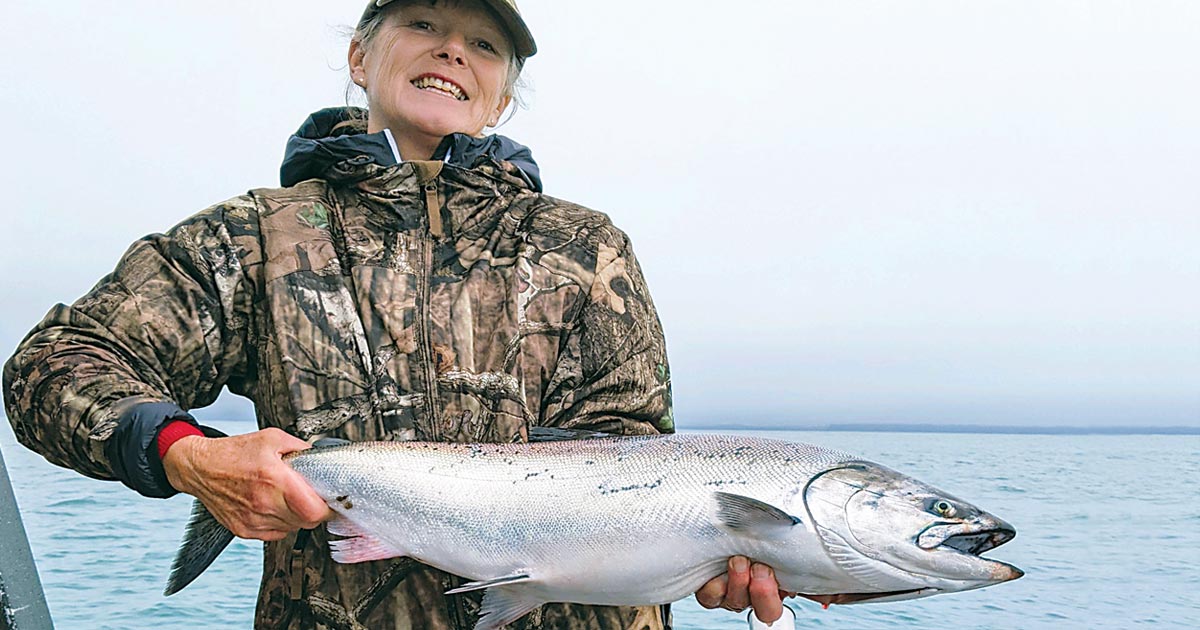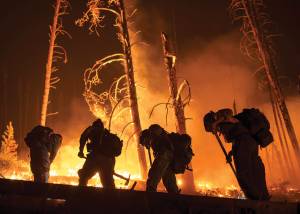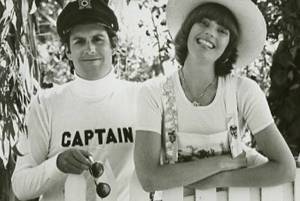By HOLLY ENDERSBY
This summer my trip to Alaska was also a return trip for my son, who guided there 30 years ago. I’ve always enjoyed fishing with Todd: he’s a master angler in fresh or salt water with dry fly or spinner, and he’s always a great partner on any water. But for some reason, we’d never considered fishing in rural Alaska together, so this year it seemed like we should just do it. We did, and it was marvelous.
I’ve fished in Alaska’s rivers on raft and kayak trips, and on the salt in big boats. I’ve experienced anywhere from rough-it camp trips above the Arctic to fancy fishing lodge retreats. But what we wanted was a pure fishing experience, not being pampered in a luxurious cabin with gourmet food. We wanted a place that offered both excellent river and salt fishing. And we found it in Yakutat.
My husband, Scott, fished there the previous fall and loved it. He grew up fishing on an Oregon coastal river, so it felt like home to him. We stayed in the same motel he did, and, while it wasn’t fancy, it was clean, warm, and dry, and that’s certainly enough.
The fishing is impressive in this rain-drenched part of Alaska. In four days, two on salt and two on fresh water, we caught six species: king, silver and pink salmon, rock fish, ling cod and feisty Dolly Varden. Unlike a lot of people, we love pinks when they are in the salt or just a day in a river, still spangled with sea lice and chrome bright.
The delicate flesh of pinks makes the most delicious deep fried finger food. On our first river day, we kept 18 beauties, but caught and released many more that didn’t look perfect. These fish are great fighters and have stamina to boot. Fighting pinks and keeping them out of log jams and scattered limbs embedded in the gravel was our biggest challenge. We had luck landing them on both flies and spinners with no real preference for either.
Why is fishing here so amazing? Well, the habitat is still intact. The rivers flow free, and they are wonderfully complex with tons of large, woody debris forming holding pools and miles of beautiful spawning gravel. The river is simply alive.
The bears like it that way. We surprised a big grizzly fishing as we rounded a brushy bend in the river. The bear scrambled for the bank, turned and faced us in a, “What the heck are you doing in my river?” look and stood up on his hind legs 20 feet from us, to make sure we understood the message. We didn’t linger.
The salt part of our trip was challenging as well, mostly due to rough seas the first day. But we still managed to land our one king salmon each and bring plenty of good-sized rockfish into the boat.
We love rockfish for tacos: they fry up quickly and flake easily and taste delicious.
The second day was easier on the stomach and found us in good ling cod water and we hauled in one big one each. Silvers and pinks started showing up in numbers as well, so we scored there, too. We’d hoped for halibut but they simply weren’t there. According to the captain, commercial fleets had severely depleted the fish numbers.
Our last river day was a doozy: rain was torrential, and the water was rising fast. Within minutes of stepping from our rig, we were soggy, despite waders and, in my case, two rain jackets. The seas were rough again, which we could tell from the number of anglers wading and casting in the river.
Lodges had moved from the salt to bringing clients to fresh water. If you’ve ever fished in rapidly rising river water, you know staying safe in the current is difficult. Not only do you have to keep an eye out for debris coming by, but you need to be watching the rise, so you don’t get in trouble. I elected to stay close to shore. My husband and son waded deeper and had some luck landing pinks, but even they were challenged by the sheer volume of water.
This same river is Mecca to fly fishermen in September, when robust numbers of coho salmon come charging into the fresh water, eager to spawn. With water this clear and cold, it’s hard to find a better spot to fish for silvers.
As we gathered to have our pre-dinner drinks later that day—after we got dry and warm—we were happy with all we’d done. Three fish boxes were full and ready to leave with us.
Part of the allure of Alaska is experiencing the difference from your Lower 48 life. But, if you can’t embrace weather challenges, limited housing options, or lots of milk-run flights to get where you’re going, then rural Alaska fishing is not for you. But if you’re OK with being flexible, and you enjoy the rush of superb fishing, then just go. You’ll never regret it. ISI










